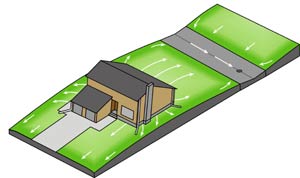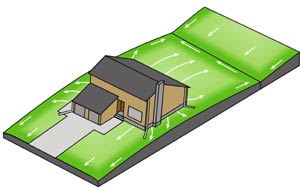Residential lot grading
Lot drainage
Lot drainage
There are three types of lot drainage:
Rear-to-front drainage
- The rear lot line is the high point on the lot.
- Surface water on the property is drained to side yard swales along the common lot line and out the front of the property toward the street.
Split drainage to a back lane
- The highest elevation is set near the midpoint on the property.
- Surface drainage then flows to the street and to the rear lot line and onto the lane.
Split drainage to a rear yard swale
- The highest elevation is set near the midpoint on the property.
- Surface drainage then flows to the street and to the rear lot line and onto a rear yard swale.
Note: It is very important to maintain elevations according to plan in a swale easement. Any change of elevation will affect not only the owner but also the neighbours.
Swale easements
A swale easement is an agreement that is registered against a property. This agreement reserves a portion of land for land drainage purposes so that neighboring properties may properly drain their storm water runoff.
Swale easements:
- are required for drainage swales in some areas,
- are shown on the approved lot grading plan and lot grade permit,
- must be maintained by the property owner.
Drainage swales:
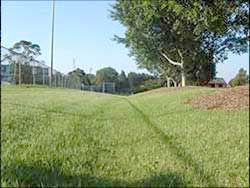
- are shallow-sided, sloped ditches designed to carry surface run-off from a property, towards the nearest street, lane, catch basin or stormwater retention basins,
- are located along common property lines and sometimes at the back of a lot,
- should be graded in accordance with the approved lot grading plan,
- must be maintained by the property owner.
Do not cover any catch basins located in swale easements. Doing so will affect drainage on your property and possibly your neighbour’s. Surface water must flow to the catch basins as part of the overall drainage design.
Swales must be unobstructed and free draining.
- Do not plant trees in a swale, as over time, a large tree can affect the drainage.
- Do not fill in the bottom with decorative landscaping material above the design grade as it will dam water when frozen.
- Keep fences at least 150 mm (6 inches) above the bottom of a swale to allow water to pass under it.
- Shovel off the snow in spring to allow for earlier drainage as the snow melts.
Perching
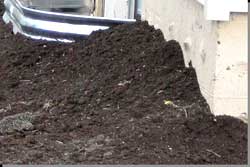
- is the sloping of soil away from a structure, directing surface drainage away from the foundation and window wells,
- reduces the volume of water flowing to the weeping tiles.
Build up the ground around your house so that water flows away from your foundation. Also, examine sidewalks, patios, decks and driveways. These can settle overtime and cause water to drain back towards the house.
Window wells
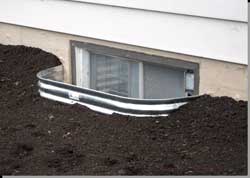
- are rounded metal or concrete walls installed around basement windows,
- allow the ground around the basement/foundation to be raised to achieve proper slope away from the foundation.


